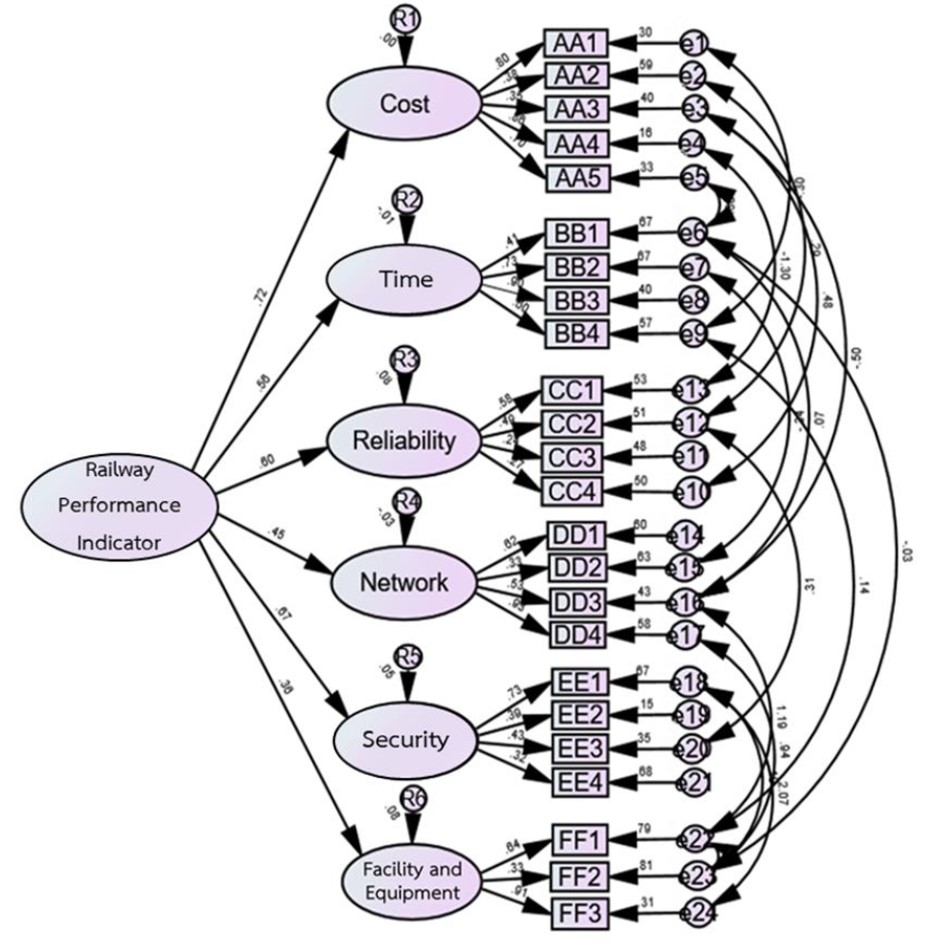An application of Confirmatory Factor Analysis (CFA) for measurement modeling on rail freight performance indicators: Case study on Thailand's new double-track railway
Main Article Content
Abstract
The main objective of this research is to formulate a measurement model encompassing rail freight performance indicators for newly established double-track railway routes through the application of Confirmatory Factor Analysis (CFA). Employing a questionnaire as the primary data collection tool, this study specifically focuses on factors related to rail freight performance. The sample size comprises 150 entrepreneurs, including Logistics Service Providers (LSPs), warehouse operators, and distribution center operators. The performance indicators utilized in this investigation, derived from an extensive literature review, constitute the relevant factors. Subsequently, the performance indicators of rail freight transportation were analyzed using Confirmatory Factor Analysis (CFA). The findings indicate a consistent alignment between the proposed model and empirical data (χ2 = 244.728, χ2 /df = .967, df = 253, p = .634, GFI = .990, AGFI = .970, CFI = 1.000, RMR = .036, RMSEA = .000). Based on the result of the proposed measurement model, the most significant performance indicator is Cost (transportation costs), exerting considerable influence on entrepreneurs in their selection of transportation modes. Other indicators, namely, Time (transportation time), Reliability, Network (rail network accessibility), Security, Facility and Equipment, are deemed secondary factors. Consequently, organizations responsible for the operation of double-track railways must prioritize attention to these indicators to incentivize entrepreneurs to opt for rail transportation, thereby augmenting the volume of the rail transport mode.
Article Details

This work is licensed under a Creative Commons Attribution-NonCommercial-NoDerivatives 4.0 International License.
This work is licensed under a Creative Commons Attribution-NonCommercial-NoDerivatives 4.0 International License.
References
Arnott R, Kraus M. Principles of transport economics. In: Hall RW, editor. Handbook of transportation science. Boston: Springer; 2003. p. 689-726.
Martsenyuk LV, Vyshniakova AV. Improvement of freight transportation process and their management mechanism. Science and Transport Progress. 2014;2(50):41-8. (In Ukrainian)
Siridhara S, Paonoi W, Meeyai S, Ratanavaraha V. Container transport mode choice analysis with a binary logit model case study: Northeastern Thailand. Eng Appl Sci Res. 2019;46(3):256-66.
Eatough CJ, Brich SC, Demetsky MJ. A statewide intermodal freight transportation planning methodology. J Transp Res Forum. 2000, 39(1):145-55.
Mlinarić TJ, Đorđević B, Krmac E. Evaluation framework for key performance indicators of railway ITS. Promet-Traffic Transp. 2018;30(4):491-500.
Jung H, Kim J, Shin K. Importance analysis of decision making factors for selecting international freight transportation mode. Asian J Shipp Logist. 2019;35(1):55-62.
Arencibia AI, Feo-Valero M, García-Menéndez L, Román C. Modelling mode choice for freight transport using advanced choice experiments. Transp Res A: Policy Pract. 2015;75:252-67.
Tavasszy L, van de Kaa G, Liu W. Importance of freight mode choice criteria: an MCDA approach. J Supply Chain Manage Scie. 2020;1(1-2):27-44.
Malhotra N, Hall J, Shaw M, Oppenheim P. Essentials of marketing research: an applied orientation. 2nd ed. Australia: Pearson Education Australia; 2007.
Sathapongpakdee P. Industry Outlook 2019-2021: Road Freight Transportation Service [Internet]. 2019 [cited 2021 Sep 12]. Available from: https://www.krungsri.com/en/research/industry/industry-outlook/logistics/road-freight-transportation/io/io-road-freight-transportation-20.
Hair JF, Black WC, Babin BJ, Anderson RE. Multivariate data analysis. 7th ed. Upper Saddle River: Pearson; 2010.
Hair JF, Black WC, Babin BJ, Anderson RE. Multivariate data analysis. 8th ed. Hampshire: Cengage Learning; 2018.
Suwantarathip O, Orawiwatnakul W. Using mobile-assisted exercises to support students' vocabulary skill development. Turkish Online J Educ Technol: TOJET. 2015;14(1):163-71.
Schumacker RE, Lomax RG. A beginner’s guide to structural equation modeling. 3rd ed. New York: Routledge; 2010.
Hancock GR, Mueller RO. Rethinking construct reliability within latent variable systems. In: Cudeck R, du Toit S, Sørbom D, editor. Structural equation modeling: Present and future. Lincolnwood: Scientific Software International; 2001. p. 195-216.
Ellison SLR, Barwick VJ, Duguid Farrant TJ. Practical statistics for the analytical scientist: a bench guide. 2nd ed. Cambridge: RSC Publishing; 2009.
Haron S, Nasir MSB, Mohamad SS. Mohamad. Rail transport service performance indicators in Klang Valley. AIP Conf Proc. 2016;1774:030022.
Tripathi S, Hudnurkar M, Ambekar SS. Selection of mode of transport for freight movement. Int J Innov Sci. 2021;13(3):268-85.
Vedant GVSK. Choose the right mode of transportation for your cargo! [Internet]. 2022 [2024 Jan 23]. Available form: https://www.20cube.com/blog/choose-the-right-mode-of-transportation-for-your-cargo/.
Fornell C, Larcker DF. Evaluating structural equation models with unobservable variables and measurement error. J Mark Res. 1981;18(1):39-50.
Kim HC, Nicholson A, Kusumastuti D. Freight transport mode choice and mode shift in New Zealand: findings of a revealed preference survey. In: Macharis C, Melo S, Woxenius J, Lier TV, editor. Sustainable Logistics: Transport and Sustainability vol.6. Leeds: Emerald Publishing Limited: 2014. p. 165-92.



